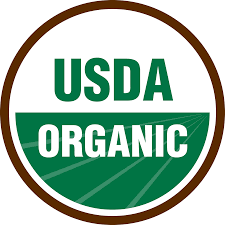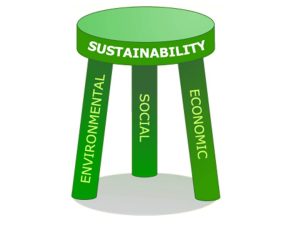—John Wooden, Hall of Fame basketball coach
Last time we talked about some of the thousands of different products, the “what” you can produce on a farm, from livestock to bees and fish, from trees for lumber and fruit, to vegetables and even fungi. “How” we produce these products matters; financially, environmentally and in many other ways. Sustainability guides—or, should guide—how we hope to produce food, feed, fuel, and fiber on our farms. These sustainability details matter, but need to be balanced with productivity, profitability, and risk.
The United States has one of the most productive agricultural systems in the world. Americans spend among the lowest percentages of their income on food of any country, in large part because we have such high incomes rather than our food being the least expensive. Although our production systems are extremely efficient, supply chain entities other than producers wind up capturing a large chunk of those savings. Processors, packagers, retailers and, yes, even some (larger or value-added) producers can be very profitable.
Not always best to be first in line!
KEY QUESTIONS
• Who?
• Why?
• What?
• Where?
• When?
In most industries, it is not the raw commodity producer who makes the highest margin but the downstream players that add differentiated value or control market access. In that regard, the farming industry isn’t that much different than plastics, basic chemical ingredients, iron-ore production or textiles. Econ 101 teaches us that those first in the supply chain at the raw commodity level don’t always make the most money. It doesn’t have to be that way. The producer can differentiate by how they grow crops or raise animals and appeal to customer wishes, but, the practice should be meaningful and deliver beneficial outcomes. Not just sound good.
Sometime, efficient farming systems can come at a cost to the environment, the communities in which they operate, to the labor required to keep them humming, and to the animals and land that yield the bounty. The “how” we produce our food, feed, fuel, and fiber matters, paraphrasing Coach Wooden. That “how” list, and some impacts, includes:
- Carbon footprint
- Animal welfare
- Energy and water usage
- Treatment of labor
- Healthiness of product being grown
- Impact on water, air and soil
Clear, simple and wrong!
As the famed journalist H.L. Mencken said, “For every complex problem there is an answer that is clear, simple and wrong.” We should focus on outcomes and impacts and not just the “how.” Sometimes, the “how” sounds good but doesn’t deliver. Sometimes it makes us feel good without doing good.
As an example, while the intent of growing organic sounds noble, the facts and reality are not always quite so clear. That product on the shelf or in your pantry might not be pesticide-free or chemical-free as claimed. Some pesticides cleared for organic use are more toxic than products used in traditional agriculture that we love to hate. Case in point: copper sulfate compared to that now-perennial punching bag of “Roundup.” See here and here for more details.
To understand the real give-and-take of organic, read this article from Harvard. We often sacrifice productivity and efficiency when using organic methods that yield less produce and potentially require more acres to feed the same number as traditional methods. Land being brought into production might be more erodible or less fit for agriculture. That’s not helping; rather, hurting.
 Going organic and leaving effective tools on the sidelines can increase risks for producers at a time when there are already too many risks, like climate change, market competition, and higher incidences of diseases (i.e., citrus greening), to name a few.
Going organic and leaving effective tools on the sidelines can increase risks for producers at a time when there are already too many risks, like climate change, market competition, and higher incidences of diseases (i.e., citrus greening), to name a few.
Absolutism drives much of the newest thinking in agriculture: that is, pesticide-free and non-GMO (genetically modified organism). Consider utilitarianism, factoring in the greatest good for the greatest number. Maybe we need to compromise: use fewer pesticides with high toxicities (including copper sulfate) and cut down on herbicide-dependent GMOs while boosting use of GMOs that reduce the levels of cancer-causing agents in potato or increase the amount of vitamin A in rice, which helps prevent childhood blindness.
A measure of intelligence is being able to hold opposing ideas in your head at the same time and still function. We can operate in the gray area. Most of our life is already lived there. You might want to question the real motives of the absolutists.
The other side to the story
Organic standards prevent any use of synthetic fertilizers, but why? The Four Rs should be considered: Right Time, Right Place, Right Amount, and Right Way. We can accomplish the outcome of less impact on the environment (by using the Four Rs) without throwing the baby (fertilizer) out with the bathwater.
But what about the mining of phosphates and their impact on the environment? Legitimate question. What about the production of animal manures and the potential impact of the animals on water quality and CO2 emissions. Composting while having many benefits is not environmentally neutral.
Sustainability is a stool with at least three legs: environmental, social and financial. All legs are important. But, if the financial leg is not feasible, then the others won’t be addressed. Their benefits go unrealized. And, the stool topples.
Maybe we need to consider tradeoffs. If we can reduce CO2 emissions by 80% rather than 100% and still allow a profitable return, then we should. Relativism and utilitarianism, not absolutism, should be the wise choice. Use the Four Rs to reduce synthetic fertilizer usage and lessen environmental impact by 80% while still creating more profitable production, farm financial sustainability, and the ability to feed billions.
As you decide “how” you want to farm, do your due diligence and determine if the “how” has measurable, tangible outcomes and benefits. Don’t get swayed by influencers who have motives. Just. Like. Everybody. Else. (Click-bait anyone?)
I want you to be successful (do well) and also make a real difference (do good). They aren’t mutually exclusive.
 7
7

